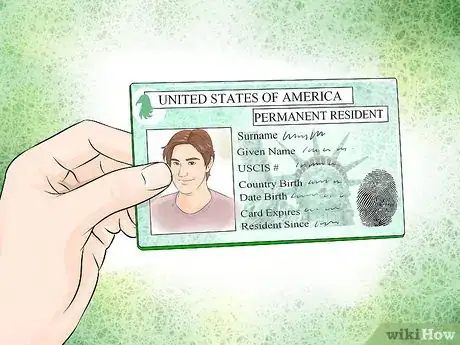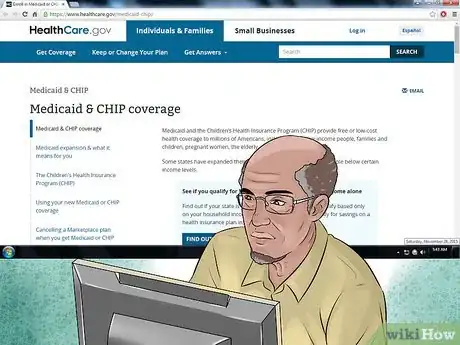This article was co-authored by Clinton M. Sandvick, JD, PhD. Clinton M. Sandvick worked as a civil litigator in California for over 7 years. He received his JD from the University of Wisconsin-Madison in 1998 and his PhD in American History from the University of Oregon in 2013.
There are 10 references cited in this article, which can be found at the bottom of the page.
This article has been viewed 54,414 times.
Medicaid exists to help people afford medical costs and provides aid to men, women, and children of all ages. Medicaid is a federal program which is made available in and administered by every state. To enroll in the program, you will need to meet certain criteria such as income level, family size, or disability status. Many requirements will vary depending on the state you are a resident of.[1] Learn more about Medicaid to see if it might be the right choice for you or your family.
Steps
Qualifying for Medicaid
-
1Learn if you are eligible for Medicaid. There are some requirements that you should meet before you apply for Medicaid. These qualifications will vary from state to state; however, there are some commonalities that you can expect. Review the following list of qualifications to get an overview of what might be required of you.[2]
- Be at a certain income level. For example, a family of 4 can earn no more than $29,700 annually by federal requirements.
- The size of your family will determine required income level minimums. Larger families will have higher requirements for income.
- Either be disabled yourself or be the beneficiary of someone who is disabled. You may also be required to submit medical proof of any disabilities.
- State specific requirements. Some states have higher allowances for their minimum income requirements.
- Other criteria may be required such as residency, immigration status, as well as providing documents proving your U.S. citizenship.
-
2Be aware that some non-citizens may still be eligible. Even if you are not a citizen of the United States of America, you may still qualify to receive Medicaid. Review the following points to see if you fit in this category of non-citizens who may still receive Medicaid:[3]
- If you have claimed asylum or are a refugee.
- If you are a lawful permanent resident or hold a green card.
- If you were a victim of human trafficking.
- If you are a veteran or currently active member of the military.
- If you are entering from Cuba or Haiti.
- If you were under parole for more than 1 year.
- If you are a non-citizen woman or child who was a victim of battery.
Advertisement -
3Check your income level. If you live below or near the federal poverty level, you may be eligible for Medicaid. Each state will have their own requirements for income level. Compare your income to these federal and state income levels to learn if you are eligible for Medicare.[4]
- As of 2011, the Federal poverty level for a family of four is $29,700 annually.
- The Affordable Care Act of 2010 allows income levels to be 133% of the federal poverty level.
- Income level requirements will vary from state to state. For example, income levels in New York can be 149% of the federal poverty level while Maryland allows up to 317%.[5]
- A detailed list of state income requirements can be found at "www.medicaid.gov"
- Income levels are usually judged in consideration with the size of your family.
- Not all states have expanded their coverage under the Affordable Care Act. 19 states are currently not expanding coverage including Alabama, Florida, Georgia, Idaho, Kansas, Louisiana, Maine, Mississippi, Missouri, Nebraska, North Carolina, South Carolina, Oklahoma, South Dakota, Texas, Virginia, and Wisconsin.[6] [7]
-
4Learn about additional eligibility groups. If you don't find yourself fitting into one of the main groups served by Medicaid, you may want to see if you fit into the three additional eligible groups. Keep in mind that it is up to the state to cover these optional groups. Review the following list to learn more about these groups:
- Those deemed “medically needy” may be considered eligible for Medicaid. People in this group are generally above the federal poverty level, but are allowed to pay a portion of medical bills while Medicaid covers what their payment did not.
- Women who were found to have breast or cervical cancer may be eligible for Medicaid if they were otherwise found ineligible.
- People who have tuberculosis, but were otherwise ineligible, may be covered by Medicaid.
-
5Apply. If you believe that you may qualify for Medicaid then you should apply. There are a few methods that you can use to apply; however, they will all involve you applying at a state level.
- You can check to see if you are qualified on-line at healthcare.gov
- Each state will have its own methods of application.
Learning More About Medicaid
-
1Learn what and who Medicaid is intended for. There are multiple functions to the Medicaid program and different reasons that you might need to apply. Review the following functions of the Medicaid program to learn if it is a good fit for you:[8]
- Medicaid can help if you are unable to pay large medical bills.
- If you are enrolled in Medicare, you may already be qualified for Medicaid.
- There may be financial circumstances that qualify you for Medicaid, such as being below the federal poverty line.
- If you receive supplemental security income (SSI), you may automatically be eligible for Medicaid.
- Medicaid aims to provide medical aide to pregnant women, children, seniors, people with disabilities, and non-disabled individuals.[9]
-
2Understand your state Medicaid requirements. Although Medicaid is a federally funded program, it is implemented on a state level. Some states will even have their own programs that they run. You will have to learn about your own state and their requirements for enrollment in Medicaid.[10]
- You can find information about your state requirements “at this website”
- States will select on an individual level who is accepted into the Medicaid program.
- States can also choose to expand their coverage to groups beyond the federally mandated groups.
- There are some federally mandated aspects to Medicaid. These involve which groups of people are required to be covered by Medicaid.
-
3Be aware of retroactive eligibility. Medicaid may apply retroactively up to three months before you applied. If you apply and are accepted, and were also eligible three months ago, any medical bills incurred during those last three months may be covered.[11]
- Coverage under Medicaid will end when you are no longer considered eligible.
References
- ↑ https://www.healthcare.gov/medicaid-chip/getting-medicaid-chip/
- ↑ https://www.healthcare.gov/medicaid-chip/eligibility/
- ↑ https://www.medicaid.gov/sites/default/files/2020-01/overview-of-eligibility-for-non-citizens-in-medicaid-and-chip.pdf
- ↑ https://www.medicaid.gov/medicaid/eligibility/index.html
- ↑ https://www.medicaid.gov/medicaid/program-information/medicaid-and-chip-eligibility-levels/index.html
- ↑ http://kff.org/health-reform/slide/current-status-of-the-medicaid-expansion-decision/
- ↑ https://www.advisory.com/daily-briefing/resources/primers/medicaidmap
- ↑ http://www.health.ny.gov/health_care/medicaid/#definition
- ↑ https://www.medicaid.gov/medicaid/eligibility/index.html
About This Article
The specific qualification requirements for Medicaid vary from state to state, so the best way to make sure you qualify is to check your state's Medicaid website. However, there are certain national qualification requirements. For example, a family of 4 can earn no more than 20,700 dollars annually by federal requirements. You can also qualify if you’re disabled or the beneficiary of someone who is disabled. You may have to provide evidence of your disability, as well as proof of your US citizenship. If you’re not a US citizen, you may be able to claim Medicaid if you meet other criteria, such as being an asylum seeker, refugee, veteran or active member of the military. For more tips from our Legal co-author, including how to apply for retroactive medical bills under Medicaid, read on!



























































